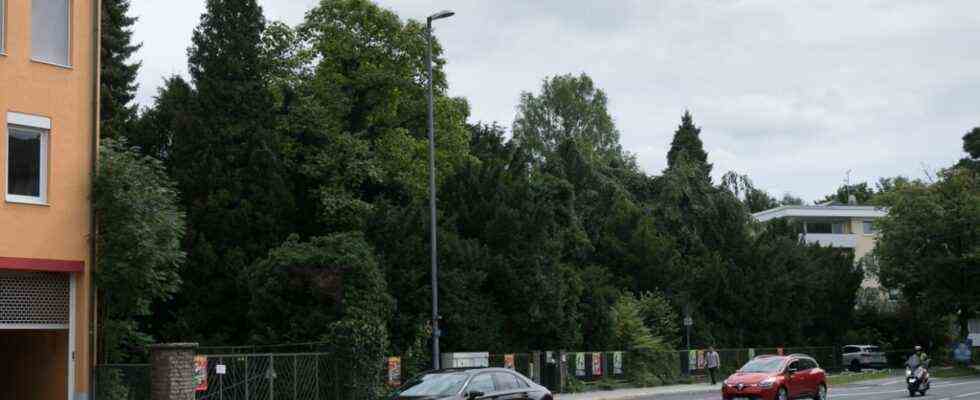The city is reaching its natural limits of growth. Munich politicians are confronted with this dilemma especially when they want to approve residential and commercial buildings. Munich not only reaches its limits, it also crosses them more and more often. For example, when valuable greenery is irretrievably lost in favor of new settlements, office complexes or streets.
Such a case seems to be looming at Ottobrunner Straße 3, where the construction of a new residential complex with underground parking is planned. So far there has only been one house on the approximately 8,000 square meter property, but there are many magnificent trees stretching their crowns into the sky. Which is why there are protests against the construction project at the local level.
While this is hardly surprising, another voice is all the more surprising, having spoken to the planning department in a letter: The Upper Palatinate-based Association for Landscape Management and Species Protection in Bavaria (VLAB) also speaks out against the redensification plans on Ottobrunner Straße 3 off. Its chairman Johannes Bradtka admits that structural redensification in cities is a necessary and indisputable measure to create affordable housing and to minimize land use in the peripheral areas. “We are very concerned, however, that redensification in Munich often takes place at the expense of valuable inner-city green spaces, which are of great importance for the urban climate, biodiversity and for the recreation and health of the urban population.”
Bradtke now complains that at Ottobrunner Strasse 3 in the front part of the property on the street, almost the entire tree population with around 120 valuable trees is to be cleared for the purpose of building. These are partly strong, old native tree species, for example yew, red beech, hanging beech, sycamore and norway maple, ash and columnar oak. In addition, numerous guest tree species – false cypress, cedar, black pine, trumpet trees, Chinese redwood, ginko, sequoia trees – thrived on the area that will be even more important than before as climate-resistant species, especially in cities.
The outstanding, healthy condition of the tall trees with trunk circumferences of up to over four meters, heights of up to 23 meters and treetops of up to 16 meters as well as the sometimes extremely high rarity value of these trees, for example a fruit-bearing ginko tree, should be emphasized. With an age between 60 and 160 years, these trees are in their high-performance phase of binding CO₂ and fine dust.
In any case, clearing these trees would thwart the “tree protection campaign” recently decided by the Committee for Urban Planning and Building Regulations, warns Bradtka. In general, one seems to be closely following the events in the state capital from the Upper Palatinate. The VLAB chairman points out Munich’s biodiversity strategy, in which, among other things, attention is drawn to the increasing loss of near-natural open spaces.
The Munich planning department listed the “increased consideration of biodiversity aspects in the establishment of development and open space design plans” as a focus of action in this strategy. The old trees at Ottobrunner Straße 3 in particular serve as a valuable habitat for numerous endangered bird and bat species that are protected under national and international species protection law.
Finally, the chairman of the VLAB asks the staff of the planning department to reconsider the ongoing review of the application for a preliminary decision and the resulting clearing of 120 trees at Ottobrunner Straße 3, taking into account biodiversity, species and climate protection and the role model function of the Thoroughly weigh up the state capital of Munich. Valuable green spaces with old trees, even if they are privately owned, should not serve as objects of speculation, but should be preserved in the public interest for biodiversity and climate protection.
In the meantime, the city council faction of the ÖDP and the Munich list has positioned itself on the same matter and with the same thrust. She has drafted a motion to be dealt with at the meeting of the Committee on Urban Planning and Building Regulations on September 15th. If this was accepted, the planning department would be commissioned to initiate the further steps for the development plan 1638.
Explanation: The property at Ottobrunner Straße 3 is within the scope of the development plan 1638. This extends between Ottobrunner Straße in the west, Diakon-Kerolt-Weg in the north, Wolf-Huber-Weg in the east and Gleißnerstraße in the south. According to the application, the aim of the development plan is, on the one hand, a moderate residential development in the southern area of the development plan and the preservation of the valuable tree population and the climatologically important green areas on the site of Ottobrunner Straße 3.
In the further planning, a special examination under species protection law should be prescribed and the extraordinary tree population as a whole or at least individual trees should be designated as natural monuments. The development plan should be developed as a whole. Building permits and preliminary notices for individual areas should not be issued. For the sub-area Ottobrunner Straße 3, the applicants want to obtain a change block.

